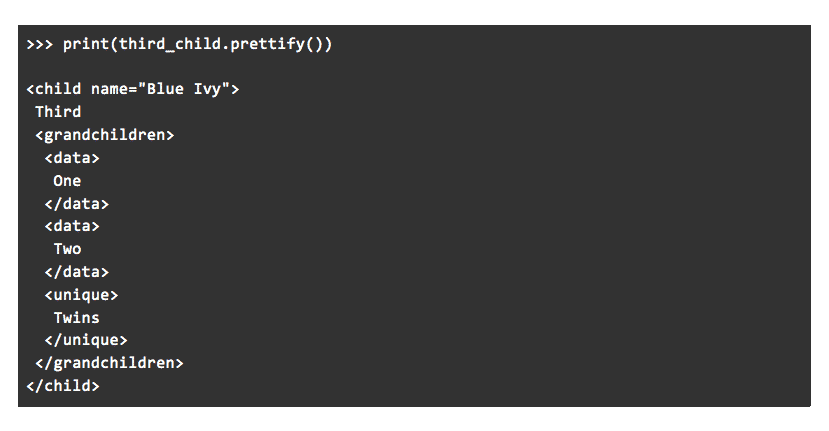There are two major aspects to parsing XML files. They are:
- Finding Tags
- Extracting from Tags
You’ll need to find the tag that holds the information you want, then extract that information. You’ll learn how to do both when working with XML files before the end of this article.
Installation
BeautifulSoup is one of the most used libraries when it comes to web scraping with Python. Since XML files are similar to HTML files, it is also capable of parsing them. To parse XML files using BeautifulSoup though, it’s best that you make use of Python’s lxml parser.
You can install both libraries using the pip installation tool, through the command below:
To confirm that both libraries are successfully installed, you can activate the interactive shell and try importing both. If no error pops up, then you are ready to go with the rest of the article.
Here’s an example:
Python 3.7.4 (tags/v3.7.4:e09359112e, Jul 8 2019, 20:34:20)
[MSC v.1916 64 bit (AMD64)] on win32
Type "help", "copyright", "credits" or "license" for more information.
>>> import bs4
>>> import lxml
>>>
Before moving on, you should create an XML file from the code snippet below. It’s quite simple, and should suit the use cases you’ll learn about in the rest of the article. Simply copy, paste in your editor and save; a name like sample.xml should suffice.
<root testAttr="testValue">
The Tree
<children>
<child name="Jack">First</child>
<child name="Rose">Second</child>
<child name="Blue Ivy">
Third
<grandchildren>
<data>One</data>
<data>Two</data>
<unique>Twins</unique>
</grandchildren>
</child>
<child name="Jane">Fourth</child>
</children>
</root>
Now, in your Python script; you’ll need to read the XML file like a normal file, then pass it into BeautifulSoup. The remainder of this article will make use of the bs_content variable, so it’s important that you take this step.
from bs4 import BeautifulSoup as bs
content = []
# Read the XML file
with open("sample.xml", "r") as file:
# Read each line in the file, readlines() returns a list of lines
content = file.readlines()
# Combine the lines in the list into a string
content = "".join(content)
bs_content = bs(content, "lxml")
The code sample above imports BeautifulSoup, then it reads the XML file like a regular file. After that, it passes the content into the imported BeautifulSoup library as well as the parser of choice.
You’ll notice that the code doesn’t import lxml. It doesn’t have to as BeautifulSoup will choose the lxml parser as a result of passing “lxml” into the object.
Now, you can proceed with the rest of the article.
Finding Tags
One of the most important stages of parsing XML files is searching for tags. There are various ways to go about this when using BeautifulSoup; so you need to know about a handful of them to have the best tools for the appropriate situation.
You can find tags in XML documents by:
- Names
- Relationships
Finding Tags By Names
There are two BeautifulSoup methods you can use when finding tags by names. However, the use cases differ; let’s take a look at them.
find
From personal experience, you’ll use the find method more often than the other methods for finding tags in this article. The find tag receives the name of the tag you want to get, and returns a BeautifulSoup object of the tag if it finds one; else, it returns None.
Here’s an example:
>>> print(result)
<data>One</data>
>>> result = bs_content.find("unique")
>>> print(result)
<unique>Twins</unique>
>>> result = bs_content.find("father")
>>> print(result)
None
>>> result = bs_content.find("mother")
>>> print(result)
None
If you take a look at the example, you’ll see that the find method returns a tag if it matches the name, else it returns None. However, if you take a closer look at it, you’ll see it only returns a single tag.
For example, when find(“data”) was called, it only returned the first data tag, but didn’t return the other ones.
GOTCHA: The find method will only return the first tag that matches its query.
So how do you get to find other tags too? That leads us to the next method.
find_all
The find_all method is quite similar to the find method. The only difference is that it returns a list of tags that match its query. When it doesn’t find any tag, it simply returns an empty list. Hence, find_all will always return a list.
Here’s an example:
>>> print(result)
[<data>One</data>, <data>Two</data>]
>>> result = bs_content.find_all("child")
>>> print(result)
[<child>First</child>, <child>Second</child>, <child>
Third
<grandchildren>
<data>One</data>
<data>Two</data>
<unique>Twins</unique>
</grandchildren>
</child>, <child>Fourth</child>]
>>> result = bs_content.find_all("father")
>>> print(result
[]
>>> result = bs_content.find_all("mother")
>>> print(result)
[]
Now that you know how to use the find and find_all methods, you can search for tags anywhere in the XML document. However, you can make your searches more powerful.
Here’s how:
Some tags may have the same name, but different attributes. For example, the child tags have a name attribute and different values. You can make specific searches based on those.
Have a look at this:
>>> print(result)
<child name="Rose">Second</child>
>>> result = bs_content.find_all("child", {"name": "Rose"})
>>> print(result)
[<child name="Rose">Second</child>]
>>> result = bs_content.find("child", {"name": "Jack"})
>>> print(result)
<child name="Jack">First</child>
>>> result = bs_content.find_all("child", {"name": "Jack"})
>>> print(result)
[<child name="Jack">First</child>]
You’ll see that there is something different about the use of the find and find_all methods here: they both have a second parameter.
When you pass in a dictionary as a second parameter, the find and find_all methods further their search to get tags that have attributes and values that fit the provided key:value pair.
For example, despite using the find method in the first example, it returned the second child tag (instead of the first child tag), because that’s the first tag that matches the query. The find_all tag follows the same principle, except that it returns all the tags that match the query, not just the first.
Finding Tags By Relationships
While less popular than searching by tag names, you can also search for tags by relationships. In the real sense though, it’s more of navigating than searching.
There are three key relationships in XML documents:
- Parent: The tag in which the reference tag exists.
- Children: The tags that exist in the reference tag.
- Siblings: The tags that exist on the same level as the reference tag.
From the explanation above, you may infer that the reference tag is the most important factor in searching for tags by relationships. Hence, let’s look for the reference tag, and continue the article.
Take a look at this:
>>> print(third_child)
<child name="Blue Ivy">
Third
<grandchildren>
<data>One</data>
<data>Two</data>
<unique>Twins</unique>
</grandchildren>
</child>
From the code sample above, the reference tag for the rest of this section will be the third child tag, stored in a third_child variable. In the subsections below, you’ll see how to search for tags based on their parent, sibling, and children relationship with the reference tag.
Finding Parents
To find the parent tag of a reference tag, you’ll make use of the parent attribute. Doing this returns the parent tag, as well as the tags under it. This behaviour is quite understandable, since the children tags are part of the parent tag.
Here’s an example:
>>> print(result)
<children>
<child name="Jack">First</child>
<child name="Rose">Second</child>
<child name="Blue Ivy">
Third
<grandchildren>
<data>One</data>
<data>Two</data>
<unique>Twins</unique>
</grandchildren>
</child>
<child name="Jane">Fourth</child>
</children>
Finding Children
To find the children tags of a reference tag, you’ll make use of the children attribute. Doing this returns the children tags, as well as the sub-tags under each one of them. This behaviour is also understandable, as the children tags often have their own children tags too.
One thing you should note is that the children attribute returns the children tags as a generator. So if you need a list of the children tags, you’ll have to convert the generator to a list.
Here’s an example:
>>> print(result)
[‘n Thirdn ‘, <grandchildren>
<data>One</data>
<data>Two</data>
<unique>Twins</unique>
</grandchildren>, ‘n‘]
If you take a closer look at the example above, you’ll notice that some values in the list are not tags. That’s something you need to watch out for.
GOTCHA: The children attribute doesn’t only return the children tags, it also returns the text in the reference tag.
Finding Siblings
The last in this section is finding tags that are siblings to the reference tag. For every reference tag, there may be sibling tags before and after it. The previous_siblings attribute will return the sibling tags before the reference tag, and the next_siblings attribute will return the sibling tags after it.
Just like the children attribute, the previous_siblings and next_siblings attributes will return generators. So you need to convert to a list if you need a list of siblings.
Take a look at this:
>>> print(previous_siblings)
[‘n‘, <child name="Rose">Second</child>, ‘n‘,
<child name="Jack">First</child>, ‘n‘]
>>> next_siblings = list(third_child.next_siblings)
>>> print(next_siblings)
[‘n‘, <child name="Jane">Fourth</child>]
>>> print(previous_siblings + next_siblings)
[‘n‘, <child name="Rose">Second</child>, ‘n‘, <child name="Jack">First</child>,
‘n‘, ‘n‘, <child name="Jane">Fourth</child>, ‘n‘]
The first example shows the previous siblings, the second shows the next siblings; then both results are combined to generate a list of all the siblings for the reference tag.
Extracting From Tags
When parsing XML documents, a lot of the work lies in finding the right tags. However, when you find them, you may also want to extract certain information from those tags, and that’s what this section will teach you.
You’ll see how to extract the following:
- Tag Attribute Values
- Tag Text
- Tag Content
Extracting Tag Attribute Values
Sometimes, you may have a reason to extract the values for attributes in a tag. In the following attribute-value pairing for example: name=”Rose”, you may want to extract “Rose.”
To do this, you can make use of the get method, or accessing the attribute’s name using [] like an index, just as you would when working with a dictionary.
Here’s an example:
>>> print(result)
Blue Ivy
>>> result = third_child["name"]
>>> print(result)
Blue Ivy
Extracting Tag Text
When you want to access the text values of a tag, you can use the text or strings attribute. Both will return the text in a tag, and even the children tags. However, the text attribute will return them as a single string, concatenated; while the strings attribute will return them as a generator which you can convert to a list.
Here’s an example:
>>> print(result)
‘n Thirdn nOnenTwonTwinsnn‘
>>> result = list(third_child.strings)
>>> print(result)
[‘n Thirdn ‘, ‘n‘, ‘One’, ‘n‘, ‘Two’, ‘n‘, ‘Twins’, ‘n‘, ‘n‘]
Extracting Tag Content
Asides extracting the attribute values, and tag text, you can also extract all of a tags content. To do this, you can use the contents attribute; it is a bit similar to the children attribute and will yield the same results. However, while the children attribute returns a generator, the contents attribute returns a list.
Here’s an example:
>>> print(result)
[‘n Thirdn ‘, <grandchildren>
<data>One</data>
<data>Two</data>
<unique>Twins</unique>
</grandchildren>, ‘n‘]
Printing Beautiful
So far, you’ve seen some important methods and attributes that are useful when parsing XML documents using BeautifulSoup. But if you notice, when you print the tags to the screen, they have some kind of clustered look. While appearance may not have a direct impact on your productivity, it can help you parse more effectively and make the work less tedious.
Here’s an example of printing the normal way:
<child name="Blue Ivy">
Third
<grandchildren>
<data>One</data>
<data>Two</data>
<unique>Twins</unique>
</grandchildren>
</child>
However, you can improve its appearance by using the prettify method. Simply call the prettify method on the tag while printing, and you’ll get something visually pleasing.
Conclusion
Parsing documents is an important aspect of sourcing for data. XML documents are pretty popular, and hopefully you are better equipped to take them on, and extract the data you want.
From this article, you are now able to:
- search for tags either by names, or relationships
- extract data from tags
If you feel quite lost, and are pretty new to the BeautifulSoup library, you can check out the BeautifulSoup tutorial for beginners.








